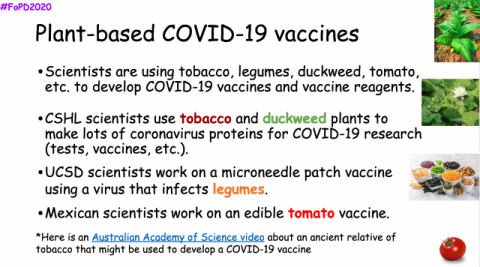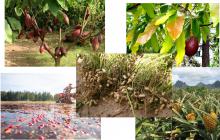The fascinating origin of some favorite foods and how plants help in the fight against COVID-19
For the past six years, Gramene has celebrated Fascination of Plants Day (FoPD) with an activity designed for K-12 children to spread our appreciation for plants. The year 2020 was not the exception. While students and teachers in New York State - as in many other parts of the world - were in home quarantine due to the threat of rapid COVID-19 spread, online instruction flourished, and Gramene seized the opportunity to also celebrate FoPD virtually.
On June 11th, Gramene's project manager and outreach, education and training coordinator, Dr. Marcela Karey Tello-Ruiz of Cold Spring Harbor Laboratory gave an online presentation to fifth graders at Bayville's Intermediate (BI) School in New York to talk about where some favorite plant-derived foods come from, and how plants are helping in the fight against COVID-19.
Through an interactive presentation, BI students learned fun facts about the plants where some common foods like the peanuts in peanut butter, the cocoa in chocolate or the avocados in guacamole, come from. Students had fun guessing at the type of plant from where peanuts are harvested from, and observing cocoa and avocado trees, native American cranberry vines, as well as tropical pineapple plants. It was particularly interesting for students to learn that peanuts are a type of underground nut, and that farmers routinely flood cranberry vines to harvest the fruit as it floats.
During the second part of the presentation, the focus was on how plants are enabling making reagents for COVID-19 research. In other words, plant-derived components being produced relatively quickly and in large quantities to develop diagnostic COVID-19 tests, vaccines, and treatments.
Plant immunity has been studied by plant scientists for many years. Students learned that plants defend themselves from viruses and other pathogens through innate immunity mechanisms, a sort of inherited resistance to diseases, but they can also aquire such resistance, for example by being crossed to resistant varieties. Studying such mechanisms could reveal some clues for fending off an infection by SARS-CoV-2, the virus that causes COVID-19.
Moreover, some plants produce certain compounds that are being tested as potential treatments for COVID-19. One example are derivatives of quinine, a compound found in the bark of a tree and once used to fight malaria.
Another way in which plants are contributing to COVID-19 research was described above and is known as "molecular pharming", a process through which plants like tobacco, legumes, duckweed, and tomato are used as “bio-factories” to produce large quantities of reagents for COVID-19 research (1-7). During this process, particles that mimic SARS-CoV-2 can be produced en masse in plants and then used to make plant-based vaccines (plants do not develop "plantibodies" themselves, but the virus-like proteins they are guided to produce are capable to stimulate an immune response in humans without causing the disease, like a vaccine).
Some interesting examples presented included scientists at the Cold Spring Harbor Laboratory using tobacco and duckweed plants to make large amounts of coronavirus proteins for COVID-19 research (1), scientists from the University of California San Diego working on a slow-release microneedle patch vaccine using a virus that infects legumes (2), and Mexican scientists working on an edible tomato vaccine (3).
The virtual FoPD activity concluded with the children watching a short Australian Academy of Science video about an ancient relative of tobacco that might be useful in the development of a COVID-19 vaccine.
Special thanks to Mrs. Christine Arthur for enabling the presentation of this FoPD activity to her 5th grade students.
Visit Gramene's Facebook page and follow us on Twitter for other outreach and educational activities that Gramene has brought to K-12 students in past years to celebrate FoPD.
#FoPD #FoPD2020 #PlantDay @PlantDay18May #Covid19vaccine
(1) https://www.cshl.edu/coronavirus-research-in-plants
(5) https://www.bat.com/group/sites/UK__9D9KCY.nsf/vwPagesWebLive/DOBN8QNL
(6) https://www.cragenomica.es/crag-news/covid-19-how-plant-biotechnology-can-help
(7) https://massivesci.com/articles/plantibody-influenza-covid19-coronavirus-flu-vaccine-antibody

Scientists around the world are working to make reagents for plant-based COVID-19 vaccines

It's fun to find out how some of our favorite foods grow! Left to right, top to bottom: cocoa, avocado, peanuts, cranberries, and pineapples.
- marcela.karey's blog
- Log in to post comments
